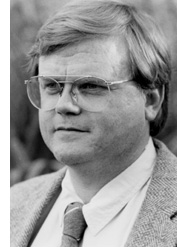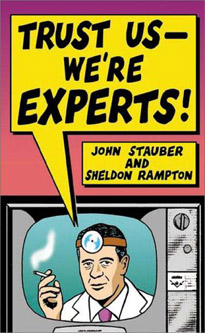Shaping the Message, Distorting the Science
 Mr. Rampton goes to WashingtonI've been asked to deliver testimony this Wednesday before the Committee on Science and Technology of the U.S. House of Representatives, which is holding a hearing titled "Shaping the Message, Distorting the Science: Media Strategies to Influence Science Policy."
Mr. Rampton goes to WashingtonI've been asked to deliver testimony this Wednesday before the Committee on Science and Technology of the U.S. House of Representatives, which is holding a hearing titled "Shaping the Message, Distorting the Science: Media Strategies to Influence Science Policy."
The written statement that I've prepared appears below. In addition, I'm told there will be about an hour of questions and answers. Other hearing witnesses include Dr. James J. McCarthy, Harvard University's Alexander Agassiz Professor of Biological Oceanography and a Board Member of the Union of Concerned Scientists, and Tarek Maassarani of the Government Accountability Project.
If you're interested in tuning in to watch, the testimony will be webcast from 2:00 to 4:30 p.m. Eastern Standard Time. You can find the webcast at the committee's website, at:
http://science.house.gov/publications/hearings_markups_details.aspx?NewsID=1736
Testimony of Sheldon Rampton
Research Director, Center for Media and Democracy
before the US House of Representatives
Committee on Science and Technology
March 28, 2006
The power that science wields in modern society is a reflection of its ability to create knowledge that is as reliable as any product of human endeavor. The very prestige of science, however, also makes it an attractive tool for manipulating public opinion. You can find science being used for that purpose, for example, in the advertisements and television commercials which announce that "laboratory tests prove toothpaste X whitens teeth whiter," or "nine out of ten doctors agree" that brand X is better than brand Y. Advertising, however, is only the most visible aspect of a variety of modern persuasive techniques that include public relations and lobbying -- all branches of what should more properly be termed a modern propaganda industry. Some of these techniques are actually more subtle and hidden than advertising. The use of endorsements by scientific experts to sell a product or policy is often done without public disclosure that the experts have been recruited or paid to do so. This technique has become so common that the public relations industry has a standard term for it. They call it the "third party technique."
The idea behind this phrase is that the PR firm's client -- typically some company, industry or other special interest -- is the "first party" interested in delivering some persuasive message to a "second party," its audience. However, experience shows that if the message is seen as coming directly from the client, the audience will treat the message with skepticism because it is so obviously self-serving. To give the message more credibility, therefore, lobbyists and PR firms find that it helps if they can use a third party who seems independent to deliver it for them. One public relations executive has explained the third party technique as, "Put your words in someone else's mouth." It turns out that the prestige and power of science makes scientists, academics, doctors and other professional experts very useful third-party spokespersons if they can be recruited for this purpose.
Sometimes this technique is used to exaggerate the benefits of a product. Other times it is used to create doubt about a product's hazards. In public policy debates, it can be used to cast doubt about the seriousness of problems requiring government action. Conversely, sometimes it is used to exaggerate dangers in order to build pressure for legislation or other government action that the client desires.
 Parts of this testimony are taken from our 1997 book, Trust Us, We're Experts: How Industry Manipulates Science and Gambles With Your FutureScientific journals are now routinely used to serve companies' marketing and public policy objectives, sometimes with serious consequences. The tobacco industry is well known for its PR manipulations of science. Many instances of this have now become public knowledge thanks to whistleblowers and lawsuits that resulted in the public release of millions of pages of once-secret industry documents. Clear scientific evidence showing the link between smoking and lung cancer first emerged in the early 1950s. Public recognition of the extent of this hazard was delayed for decades due to aggressive public relations by the tobacco industry, and even today the industry is involved in rearguard efforts to downplay the dangers of hazards such as secondhand smoke. A few years ago, for example, documents came to light regarding an industry-sponsored campaign in the early 1990s to plant sympathetic letters and articles in influential medical journals. Tobacco companies had secretly paid 13 scientists a total of $156,000 simply to write them. One biostatistician received $10,000 for writing a single, eight-paragraph letter that was published in the Journal of the American Medical Association. Another received $20,137 for writing four letters and an opinion piece to the Lancet, the Journal of the National Cancer Institute and the Wall Street Journal. These scientists did not even have to write the letters themselves. The tobacco industry's law firms did the actual drafting and editing.
Parts of this testimony are taken from our 1997 book, Trust Us, We're Experts: How Industry Manipulates Science and Gambles With Your FutureScientific journals are now routinely used to serve companies' marketing and public policy objectives, sometimes with serious consequences. The tobacco industry is well known for its PR manipulations of science. Many instances of this have now become public knowledge thanks to whistleblowers and lawsuits that resulted in the public release of millions of pages of once-secret industry documents. Clear scientific evidence showing the link between smoking and lung cancer first emerged in the early 1950s. Public recognition of the extent of this hazard was delayed for decades due to aggressive public relations by the tobacco industry, and even today the industry is involved in rearguard efforts to downplay the dangers of hazards such as secondhand smoke. A few years ago, for example, documents came to light regarding an industry-sponsored campaign in the early 1990s to plant sympathetic letters and articles in influential medical journals. Tobacco companies had secretly paid 13 scientists a total of $156,000 simply to write them. One biostatistician received $10,000 for writing a single, eight-paragraph letter that was published in the Journal of the American Medical Association. Another received $20,137 for writing four letters and an opinion piece to the Lancet, the Journal of the National Cancer Institute and the Wall Street Journal. These scientists did not even have to write the letters themselves. The tobacco industry's law firms did the actual drafting and editing.
The tobacco industry is hardly alone, however, in attempting to manipulate the scientific publishing process. As the Wall Street Journal reported in December 2005, "Many of the articles that appear in scientific journals under the byline of prominent academics are actually written by ghostwriters in the pay of drug companies." Used by doctors to guide their care of patients, these "seemingly objective articles ... are often part of a marketing campaign." To promote the diet-drug combo fen-phen, for example, Wyeth-Ayerst Laboratories commissioned ghostwriters to write ten articles for publication in peer-reviewed medical journals. After fen-phen was linked to heart valve damage and lung disease, the company was forced to pull the drugs from the market. Subsequent lawsuits filed by injured fen-phen users unearthed internal company documents showing that Wyeth-Ayerst had also edited the draft articles to play down and occasionally delete descriptions of side effects. The final articles were published under the names of prominent researchers, one of whom claimed later in courtroom testimony that he had no idea that the pharmaceutical company had commissioned the article on which his own name appeared. "It's really deceptive," he told the court. "It sort of makes you uneasy."
How does a doctor's name appear an article without him knowing who sponsored it? The process involved an intermediary hired by Wyeth-Ayerst named Excerpta Medica. Excerpta received $20,000 for each article written by its ghostwriters. It then lined up well-known university researchers and paid them honoraria of $1,000 to $1,500 to edit the drafts and lend their names to the final work. One of the name-brand researchers even sent a letter back praising Excerpta's ghostwriting skills. He joked, "Perhaps I can get you to write all my papers for me! My only general comment is that this piece may make [fen-phen] sound better than it really is."
 Exxon puts a tiger in your think tank.A similar pattern recurs on issue after issue -- air quality, water quality, product safety, and nutrition. Scientists are seen by industry not as researchers who objectively study phenomena but as potential spokespersons to help promote positions favorable to their sponsors. This strategy has become so common that sometimes industry PR people use the term "independent scientist" without apparently thinking about what the word "independent" actually means. A few years ago, the New York Times obtained some leaked documents from the American Petroleum Institute, in which the Institute detailed its plans to spend $600,000 to develop a team of pro-industry climate scientists who would dispute the link between greenhouse gas emissions and global warming. They planned to, in their words, "identify, recruit and train a team of five independent scientists to participate in media outreach." Somehow the authors of this plan never bothered to ask themselves how a scientist who has been specifically recruited and trained by the petroleum industry could be honestly described as "independent."
Exxon puts a tiger in your think tank.A similar pattern recurs on issue after issue -- air quality, water quality, product safety, and nutrition. Scientists are seen by industry not as researchers who objectively study phenomena but as potential spokespersons to help promote positions favorable to their sponsors. This strategy has become so common that sometimes industry PR people use the term "independent scientist" without apparently thinking about what the word "independent" actually means. A few years ago, the New York Times obtained some leaked documents from the American Petroleum Institute, in which the Institute detailed its plans to spend $600,000 to develop a team of pro-industry climate scientists who would dispute the link between greenhouse gas emissions and global warming. They planned to, in their words, "identify, recruit and train a team of five independent scientists to participate in media outreach." Somehow the authors of this plan never bothered to ask themselves how a scientist who has been specifically recruited and trained by the petroleum industry could be honestly described as "independent."
A converse strategy aims at suppressing independent scientific views, discoveries and evidence that are inconvenient to the industry or its lobbying interests. For example, the House Committee on Oversight and Government Reform recently released documents showing "hundreds of instances" where a former and current oil industry lobbyist had edited government reports to downplay the impact of human activities on global warming. The edits were by Philip A. Cooney, the former chief of staff of the White House Council on Environmental Quality. Cooney himself has no scientific credentials. He worked for the American Petroleum Institute prior to being appointed to his position within the Bush administration. He now works for Exxon Mobil.
The manipulation of science for public relations or political advantage inevitably has a corrupting effect on science itself. It undermines the integrity and objectivity of scientific research. It creates confusion in the minds of policymakers and the general public. What is needed, therefore, is greater public transparency regarding the sponsorship of science and of organizations that claim to speak on scientific matters. The public and policymakers have a right and to know who is funding research, what strings are attached to that funding, and how it may be affecting the information we use to make decisions -- especially decisions on policy matters that affect us all.
Since 1994 Sheldon Rampton has been the Research Director for the Center for Media and Democracy, a non-profit organization based in Madison, Wisconsin. Individuals and other non-profit organizations fund the Center; it does not accept government, corporate or labor union grants. Rampton has authored numerous articles, commentaries and books (with John Stauber) on the subject of this testimony including Trust Us We're Experts: How Industry Manipulates Science and Gambles With Your Future and Toxic Sludge Is Good For You: Lies, Damn Lies and the Public Relations Industry. He was born and raised in Nevada, graduated from Princeton University, and works in Madison, Wisconsin.





Comments
Unfortunately,
I couldn't get to the webcast until after you were done testifying. Did the committee ask you any questions? How about dropping the other shoe for those of us who missed out.
Webcast archive
Dear Mutternich and others,
You can download the video of the hearing here:
http://science.house.gov/publications/hearings_markups_details.aspx?NewsID=1736
Eventually, there should be a transcript as well, though that takes a while. Sheldon's still traveling, but will hopefully write about the hearing when he returns. My favorite part was Rep. [[Dana Rohrabacher]]'s claims that the real problem with regard to science and politics is the censorship of scientists who question [[global warming]].
You gotta hand it to him...
"My favorite part was Rep. Dana Rohrabacher's claims...."
He's good at it. I almost felt sorry for him for the blowback from his dinosaur fart joke. Almost.